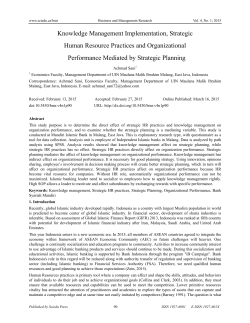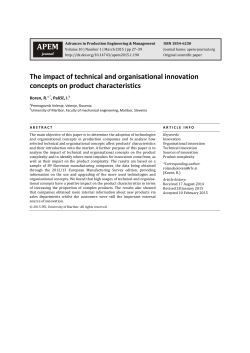
A Petri net model for the integration of purchasing
AdvancesinProductionEngineering&Management ISSN1854‐6250 Volume9|Number4|December2014|pp187–200 Journalhome:apem‐journal.org http://dx.doi.org/10.14743/apem2014.4.187 Originalscientificpaper A Petri net model for the integration of purchasing, production and packaging using Kanban system Ullah, H.a,* a Mechanical Engineering, Faculty of Engineering, Institut Teknologi Brunei, Jalan Tungku Link, Brunei A B S T R A C T AnewgenericdeterministicallytimedPetrinet(PN)modelwas developedfor the integration of purchasing, production, and packaging using the Kanban system. Firstly, the individual building blocks of the model were developed whicharethencombinedtogethertoobtaintheoverallintegratedPNmodel. Thismodelallowsthemodelingofanintegratedproductionsystemconfigu‐ ration for determining the optimal Work‐In‐Process (WIP), lead‐time, sta‐ tion’sutilization,andrateofproductionofthesystem.Eachstationcanhave multiple identical servers. The model is solved first by initial marking and thenbyoptimalmarkingusingLINGOsoftware.Themachiningservercircuit withthelargestcycletimedeterminesthebottleneckstation,asthecycletime of this circuit merely represents the capacity of the corresponding station. Elementary circuits with cycle times greater than the cycle time of the ma‐ chining server circuit are selected for optimization. These circuits result in constraints. The objective of optimization is to ensure the WIP minimum correspondstothemaximumthroughput.Themaximumthroughputwiththe minimumWIPisformulatedasalinearprogrammingproblem.Themodelcan beusedfordesigning,evaluating,andoptimizingthelayoutofanintegrated production system. This model could be extended using Fuzzy PN, Coloured PN,orQueuingPN. ©2014PEI,UniversityofMaribor.Allrightsreserved. A R T I C L E I N F O Keywords: Production Purchasing Packaging Petrinet Kanban *Correspondingauthor: hamid.ullah@itb.edu.bn (Ullah,H.) Articlehistory: Received29June2014 Revised13November2014 Accepted18November2014 AdvancesinProductionEngineering&Management ISSN1854‐6250 Letnik9|Številka4|December2014|Strani187–200 Spletnastran:apem‐journal.org http://dx.doi.org/10.14743/apem2014.4.187 Izvirniznanstveničlanek Model Petrijeve mreže za integracijo nabave, proizvodnje in pakiranja s pomočjo Kanban sistema Ullah, H.a,* a Mechanical Engineering, Faculty of Engineering, Institut Teknologi Brunei, Jalan Tungku Link, Brunei P O V Z E T E K RazvilismonovčasovnodeterminiranmodelPetrijevemreže (angl.PetriNet –PN)zaintegracijonabave,proizvodnjeinpakiranjaspomočjoKanbansis‐ tema.Modelsmozgradilipostopomaprekposameznihgradnikovdocelovite‐ gaintegralnegamodelanaosnoviPetrijevemreže.Modelomogočaoblikovan‐ jeintegriranegaproizvodnegasistemazadoločanjeoptimalnegaobsegapro‐ cesnihzalog,pretočnihčasov,izrabekapacitetstrojevinproizvodneučinkovi‐ tosticelotnegasistema.Vsakodelovnomesto(postaja)lahkoimavečidentič‐ nihstrežnikov.Modelsmonajprejrešilizzačetnimoznačevanjem,natopaz optimalnim označevanjem (tj. dodeljevanjem osnovnih postavk, žetonov) s pomočjo programske opreme LINGO. Delovno mesto z najdaljšimi proizvod‐ nimičasijeozkogrlovproizvodnji.Ciljoptimizacijejebilzagotovitiminimum procesnihzalogobsočasninajvečjizmogljivostiproizvodnje,karlahkoopre‐ delimo kot problem v okviru linearnega programiranja. Model lahko upora‐ bimozaoblikovanje,ocenjevanjeinoptimiranjerazmestitveopremevproiz‐ vodnemsistemu.RazširimogalahkospomočjopreostalihvrstPetrijevemre‐ že, npr. mehko Petrijevo mrežo (angl. Fuzzy Petri Net), obarvano Petrijevo mrežo(angl.ColouredPetriNet)int.i.QueuingPetrijevomrežo. ©2014PEI,UniversityofMaribor.Allrightsreserved. P O D A T K I O Č L A N K U Ključnebesede: Proizvodnja Nabava Pakiranje Petrijevamreža Kanban *Kontaktnaoseba: hamid.ullah@itb.edu.bn (Ullah,H.) Zgodovinačlanka: Prejet29.junija2014 Popravljen13.novembra2014 Sprejet18.novembra2014 References [1] [2] [3] [4] [5] [6] [7] [8] [9] [10] [11] [12] [13] [14] [15] [16] [17] [18] [19] [20] [21] [22] [23] [24] [25] Bassim, M.N. (2014). 8.11 – Economic implications of impact of manufacturing on environment and health, In: Hashmi, S. (ed.), Comprehensive Materials Processing, Vol. 8, Elsevier, 199-210, doi: 10.1016/B978-0-08-0965321.00817-7. Li, J., Dai, X., Meng, Z., Dou, J., Guan, X. (2009). Rapid design and reconfiguration of Petri net models for reconfigurable manufacturing cells with improved net rewriting systems and activity diagrams, Computers & Industrial Engineering, Vol. 57, No. 4, 1431-1451, doi: 10.1016/j.cie.2009.07.013. Zhang, H., Gu, M. (2009). Modeling job shop scheduling with batches and setup times by timed Petri nets, Mathematical and Computer Modelling, Vol. 49, No. 1-2, 286-294, doi: 10.1016/j.mcm.2008.03.010. Başak, Ö., Albayrak, Y.E. (2014). Petri net based decision system modeling in real-time scheduling and control of flexible automotive manufacturing systems, Computers & Industrial Engineering, In Press, Available online 13 October 2014, doi: 10.1016/j.cie.2014.09.024. Lei, H., Xing, K., Han, L., Xiong, F., Ge, Z. (2014). Deadlock-free scheduling for flexible manufacturing systems using Petri nets and heuristic search, Computers & Industrial Engineering, Vol. 72, 297-305, doi: 10.1016/ j.cie.2014.04.002. Wang, Q., Wang, Z. (2012). Hybrid heuristic search based on Petri net for FMS scheduling, In: Xiong, J. (ed.), Energy Procedia, International Conference on Future Electrical Power and Energy Systems, Vol. 17, Part A, Elsevier, 506-512, doi: 10.1016/j.egypro.2012.02.128. Wongwiwat, A., Bohez, E.L.J., Pisuchpen, R. (2013). Production scheduling for injection molding manufacture using Petri net model, Assembly Automation, Vol. 33, No. 3, 282-293, doi: 10.1108/AA-12-2013-063. Ahmad, F., Huang, H., Wang, X.-L. (2010). Petri net modeling and deadlock analysis of parallel manufacturing processes with shared-resources, The Journal of Systems and Software, Vol. 83, No. 4, 675-688, doi: 10.1016/j.jss. 2009.11.705. Tüysüz, F., Kahraman, C. (2010). Modeling a flexible manufacturing cell using stochastic Petri nets with fuzzy parameters, Expert Systems with Applications, Vol. 37, No. 5, 3910-3920, doi: 10.1016/j.eswa.2009.11.026. Murata, T. (1989). Petri nets: properties, analysis and applications, In: Proceedings of the IEEE, Vol. 77, No. 4, 541-580. Bohez, E.L.J. (2004). A new time Petri net model for design and performance analysis of a dual kanban FMS, International Journal of Production Research, Vol. 42, No. 4, 719-740, dio: 10.1080/00207540310001602900. Qiao, G., Lu, R.F., Riddick, F. (2003). Flexible modeling and simulation for mass customization manufacturing, In: Proceedings of the 2003 IIE Annual Conference, Portland, USA. Black, J.T., Ronald, A.K. (2011). DeGarmo’s materials and processes in manufacturing, 11th edition, Wiley. Jain, A., Jain, P.K., Singh, I.P. (2006). Performance modeling of FMS with flexible process plans – a Petri net approach, International Journal of Simulation Modeling, Vol. 5, No. 3, 101-113, doi: 10.2507/IJSIMM05(3)2.064. Tashnizi, E.S., Farahani, S.N., Nahrekhalaji, A.R.F. (2008). Production process optimization in flexible manufacturing system using Petri nets, In: Proceedings of the World Congress on Engineering and Computer Science, San Francisco, USA, 694-698, Mujica, M., Piera, M.A., Narciso, M. (2010). Revisiting state space exploration of timed coloured Petri net models to optimize manufacturing system’s performance, Simulation Modeling Practice and Theory, Vol. 18, No. 9, 12251241, doi: 10.1016/j.simpat.2010.04.010. Moroni, G., Petrò, S. (2013). Inspection strategies and multiple geometric tolerances, In: Jiang, X.J., Mathieu, L., Weckenmann, A., (eds.), Procedia CIRP, 12th CIRP Conference on Computer Aided Tolerancing, Huddersfield, UK, Vol. 10, Elsevier, 54-60, doi: 10.1016/j.procir.2013.08.012. Andreasen, M.M., Ahm, T. (1988). Flexible assembly system, IFS Publications, Springer-Verlag, UK. Zha, X.F., Lim, S.Y.E., Lu, W.F. (2003). A knowledge intensive multi-agent system for cooperative/collaborative assembly modeling and process planning, Journal of Integrated Design and Process Science, Vol. 7, No. 1, 99-122. Mahalik, N.P., Nambiar, A.N. (2010). Trends in food packaging and manufacturing systems and technology, Trends in Food Science & Technology, Vol. 21, No. 3, 117-128, doi: 10.1016/j.tifs.2009.12.006. Soroka, W. (2002). Fundamentals of packaging technology, 3rd edition, Institute of Packaging Professionals, Naperville, USA. Auttarapong, D. (2012). Package design expert system based on relation between packaging and perception of customer, In: Kaewkhao, J., Limsuwan, P., Yupapin, P., Janjai, S. (eds.), Procedia Engineering, Vol. 32, Elsevier, 307-314, doi: 10.1016/j.proeng.2012.01.1272. Koutsimanis, G., Getter, K., Behe, B., Harte, J., Almenar, E. (2012). Influences of packaging attributes on consumer purchase decisions for fresh produce, In: Yeomans, M. (ed.), Appetite, The 36th Annual Meeting of the British Feeding and Drinking Group, Vol. 59, No. 2, Elsevier, 270-280, doi: 10.1016/j.appet.2012.05.012. Parvini, M. (2011). 9 – Packaging and material handling, In: Farahani, R., Rezapour, S., Kardar, L. (eds.), Logistics operations and Management, Elsevier, 155-180, doi: 10.1016/B978-0-12-385202-1.00009-8. Singh, R.P., Heldman, D.R. (2014). Chapter 15 – Packaging concepts, In: Introduction to food engineering, 5th edition, Academic Press, 767-791, doi: 10.1016/B978-0-12-398530-9.00015-2.
© Copyright 2025










